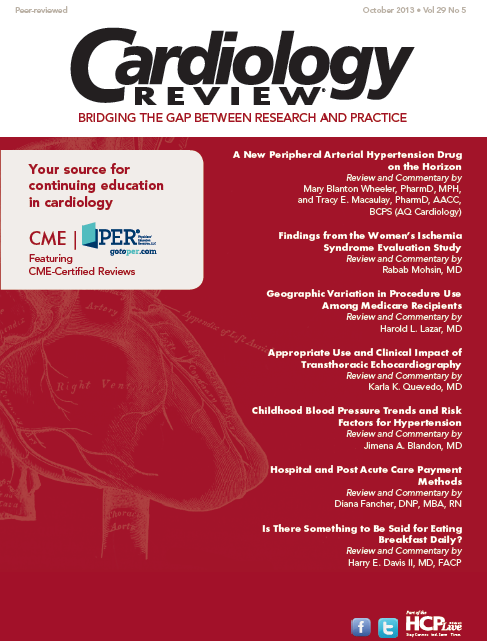Gliptins in the Treatment of Type 2 Diabetes Mellitus
Aparna M. Bhagavat, MD, FACC, says gliptins have a promising role in the control of type 2 diabetes, as they decrease A1C without hypoglycemia, weight gain, or any obvious adverse effects on cardiovascular outcomes.

Aparna M. Bhagavat, MD, FACC
This column has previously discussed the dysfunction of the pancreatic beta cells and insulin resistance. Type II diabetes mellitus (T2DM) is one of the most common causes of morbidity and mortality and thus there is a constant need for newer drugs for diabetes control. The American Association of Diabetology recommends an A1C below 7.0 to decrease microvascular as well as later macrovascular complications of T2DM.
In the past few years a new class of antidiabetic drugs, the dipeptidyl peptidase 4 (DPP-4) inhibitors (gliptins), have gained importance in the treatment of T2DM, since they do not cause hypoglycemia and weight gain, the major side effects of antidiabetic medications. The gliptins prevent the degradation of the gastrointestinal hormone incretin— glucagon-like peptide 1 (GLP1) and insulinotrophic polypeptide (GIP). Both of these augment the release of insulin from the pancreatic beta cells and decrease glucagon secretion, thus decreasing glycated hemoglobin (A1C) levels without causing hypoglycemia. Five of the gliptins (sitagliptin, saxagliptin, vildagliptin, linagliptin, and alogliptin) are already marketed (though the FDA has not yet approved vildagliptin for use in the United States). Dutogliptin and gemigliptin are in development.1
Gliptins have been shown to be noninferior to sulphonylurea, metformin, and thiazolidinediones when used as monotherapy. In combination with metformin, twice as many patients achieved A1C below 7.0, with a decrease in A1C (range, 0.5%-0.75%) compared with metformin alone.2 Sitagliptin, the first gliptin to be approved, requires changes in dosing based on patients’ renal status and is contraindicated in patients with Child-Pugh class C cirrhosis. Vildagliptin, saxagliptin, and alogliptin do not require dose adjustment for hepatic dysfunction but require it in patients with moderate to severe renal dysfunction. Linagliptin is safe in renal failure. There are no drug interactions, except with saxagliptin, which is metabolized by CYP 3A4; thus, it interacts with antifungal and antiretroviral drugs.3 The FDA issued a warning about pancreatitis with this group of drugs; however, postmarketing follow-up did not document an increased incidence of pancreatitis. Gliptins may improve cardiovascular risk by decreasing triglycerides, low-density cholesterol, and blood pressure,4-6 but the Savor TIMI 53 trial7 presented at the 2013 European Society of Cardiology (ESC) meeting showed that although there was no increase in myocardial infarction or fatal cardiovascular outcomes with saxagliptin, there was no cardiovascular protective effect, as shown by the meta-analysis of previous small trials.
Gliptins in the Elderly
Gliptins have been of interest in the elderly population because they do not cause postprandial hypoglycemia, attributed to hyposecretion of GLP-1. Thus, DPP-4 inhibitors like vildagliptin can be used for treatment in this age group.8 The studies by Schweizer et al9 in populations aged over 75 years and by Strain et al10 in patients aged over 70 years conclude that vildagliptin is safe in the elderly, and A1C targets for T2DM control can be achieved safely. The Vildagliptin in Ventricular Dysfunction Diabetes (VIVIDD) trial, presented at the Heart Failure 2013 ESC Congress, showed that although left ventricular end-systolic and end-diastolic volumes increased, the mean left ventricular ejection fraction increased and B-type natriuretic peptide (BNP) fell at 52 weeks, showing that vildagliptin did not have an adverse effect on the ejection fraction.
Gliptins have a promising role in the control of T2DM, decreasing A1C without hypoglycemia or weight gain, and with no obvious adverse effect on cardiovascular outcomes. They appear to be safe in the T2DM elderly population. It will be really interesting to see the outcomes of these drugs on newly diagnosed T2DM with no previous cardiovascular effects after a follow-up of 5 to 10 years.
References
1. Barnett A, Allsworth J, Jameson K, et al. A review of the effects of antihyperglycemic agents on body weight: the potential of incretin targeted therapies. Curr Med Res Opin. 2007;23:493-507.
2. Nathan DM, Buse JB, Davidson MB, et al. Management of hyperglycemia in type 2 diabetes: a consensus algorithm for the initiation and adjustment of therapy: a consensus statement from the American Diabetes Association and the European Association for the study of Diabetes. Diabetes Care. 2006;29:1963-1972.
3. Gupta V, Kalra S. Choosing a gliptin. Indian J Endocrinol Metab. 2011;15:298-308.
4. Drucker DJ, Sherman SI, Gorelick FS, Bergenstal RM, Sherwin RS, Buse JB. Incretin- based therapies for the treatment of type 2 diabetes: evaluation of the risks and benefits. Diabetes Care. 2010;33:428-433.
5. Peters A. Incretin-based therapies: review of current clinical trial data. Am J Med. 2010;123(3 suppl):S28-S37.
6. Patil HR, Al Badarin FJ, Al Shami HA, et al. Meta-analysis of the effect of dipeptidyl peptidase-4 inhibitors on cardiovascular risk in type 2 diabetes mellitus. Am J Cardiol. 2012;110:826-833.
7. Scirica BM, Bhatt DL, Braunwald E, et al; for the SAVOR-TIMI 53 Steering Committee and Investigators. Saxagliptin and cardiovascular outcomes in patients with type 2 diabetes mellitus. N Engl J Med. 2013. doi:10.1056/NEJMoa1307684.
8. Yonenaga A, Ota H, Honda M, et al. Marked improvement of elderly postprandial hypotension by dipeptidyl peptidase IV inhibitor. Geriatrics Gerontol Intern. 2013;13:227-229.
9. Schweizer A, Dejager S, Foley JE, Shao Q, Kothny W. Clinical experience with vildagliptin in the management of type 2 diabetes in a patient population ≥ 75 years: a pooled analysis from a database of clinical trials. Diabetes Obes Metab. 2011;13:55-64.
10. Strain WD, Lukashevich V, Kothny W, Hoellinger M-J, Paldanius PM. Individualised treatment targets for elderly patients with type 2 diabetes using vildagliptin add-on or lone therapy (INTERVAL): a 24 week, randomized, double-blind, placebo-controlled study. Lancet. 2013;382:409-416.
